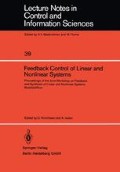Abstract
In this paper we use a recently proven “general position lemma” for transfer functions to derive several important qualitative properties, some new, of the root-locus map for multivariable systems. Among the immediate applications which we derive is that it is not in general possible to develop a formula, involving rational operations and the extraction of r-th roots, for an output feedback gain (either complex or real, should a real solution exist) which places a given set of closed-loop poles. This is in sharp contrast to the state feedback situation [2] and is a partial affirmation of a conjecture made in [3]. The technique is to reduce the problem, via global reasoning, to a tractible problem in Galois theory, Having proved this result, the prerequisite global analysis is applied to give the positive result that the pole-placement equations can, however, be solved numerically by the homotopy continuation method. Since this global analysis of the root-locus map also plays a vital role in recent work on generic stabilizability ([3], [10]) and pole placement by output feedback ([6], [9]) and has never yet appeared in its full generality, we thought it would be useful to collect these basic topological and geometric results and derive them in a coherent fashion based on the “general position lemma.”
Research partially supported by the National Science Foundation under Grant ENG-79-09459, the National Aero and Space Administration under Grant NSG-2265, and the Air Force Office of Scientific Research under Grant AFSOR 81-0054.
Research partially supported by the National Science Foundation under Grant ENG-79-09459.
Preview
Unable to display preview. Download preview PDF.
References
J.C. Alexander, “The Topological Theory of an Embedding Method,” Continuation Methods (H. Wacker, ed.), Academic Press, NY, 1978.
B.D.O. Anderson, N.K. Bose and E.J. Jury, “Output Feedback Stabilization and Related Problems — Solutions via Decision Algebra Methods,” IEEE Trans. Aut. Control, AC-20 (1975), pp. 53–66.
B.D.O. Anderson and C.I. Byrnes, “Output Feedback and Generic Stabilizability,” submitted to SIAM J. Control.
E. Artin, “Galois Theory,” University of Notre Dame Press, Notre Dame, 1971.
I. Berstein, “On the Ljusternick-Šnirel'mann Category of Grassmannians,” Proc. Camb. Phil. Soc. 79 (1976), pp. 129–134.
R.W. Brockett and C.I. Byrnes, “Multivariable Nyquist Criteria, Root-Loci and Pole Placement: A Geometric Viewpoint,” IEEE Trans. Aut. Control, AC-26 (1981), pp. 271–284.
C.I. Byrnes, “Algebraic and Geometric Aspects of the Analysis of Feedback Systems,” in Geometric Methods in Control Theory (C.I. Byrnes and C.F. Martin, eds.), D. Reidel, Dordrecht, Holland, 1980.
C.I. Byrnes, “Root Loci in Several Variables: Continuity in the High Gain Limit,” Systems and Control Letters 1 (1981), pp. 69–73.
C.I. Byrnes, “On the Topology and Arithmetic of Real Algebraic Sets,” submitted to Bull. Amer. Math. Soc.
C.I. Byrnes, “Stabilizability of Multivariable Systems and the Ljusternick-Snirel'mann Category of Real Grassmanians,” submitted to Systems and Control Letters.
S.S. Chern, Complex Manifolds without Potential Theory, Springer-Verlag, NY, 1979.
F.J. Drexler, “A Homotopy Method for the Calculation of all Zeroes of Zero Dimensional Polynomial Ideals,” in Continuation Methods (H. Wacker, ed.), pp. 69–93, Academic Press, NY, 1978.
J. Harris, “Galois Groups of Enumerative Problems,” Duke Math. J. 46 (1979), pp. 685–724.
R. Hermann and C. Martin, “Applications of Algebraic-Geometry to System Theory — Part I,” IEEE Trans. Aut. Control 22 (1977), pp. 19–25.
R. Hermann and C. Martin, “Applications of Algebraic Geometry to Systems Theory: The McMillan Degree and Kronecker Indices of Transfer Functions as Topological and Holomorphic Invariants,” SIAM J. Control 16 (1978), pp.743–755.
S. Lang, Algebra, Addison-Wesley, Reading, MA, 1971.
J. Milnor, Topology from the Differentiable Viewpoint, Univ. of Virginia Press, 1965.
A.S. Morse, W.A. Wolovich, and B.D.O. Anderson, “Generic Pole Assignment: Preliminary Results,” Proc. 20th IEEE Conf. Dec. and Control, San Diego, 1981.
D. Mumford, Algebraic Geometry I: Complex Projective Varieties, Springer-Verlag, NY, 1976.
I.R. Shafarevich, Basic Algebraic Geometry, Springer-Verlag, NY, 1974.
J.C. Willems and W.H. Hesselink, “Generic Properties of the Pole-Placement Problem,” Proc. of 7th IFAC Congress (1978), pp. 1725–1729.
Author information
Authors and Affiliations
Editor information
Rights and permissions
Copyright information
© 1982 Springer-Verlag
About this paper
Cite this paper
Byrnes, C.I., Stevens, P.K. (1982). Global properties of the root-locus map. In: Hinrichsen, D., Isidori, A. (eds) Feedback Control of Linear and Nonlinear Systems. Lecture Notes in Control and Information Sciences, vol 39. Springer, Berlin, Heidelberg. https://doi.org/10.1007/BFb0006816
Download citation
DOI: https://doi.org/10.1007/BFb0006816
Published:
Publisher Name: Springer, Berlin, Heidelberg
Print ISBN: 978-3-540-11749-0
Online ISBN: 978-3-540-39479-2
eBook Packages: Springer Book Archive

